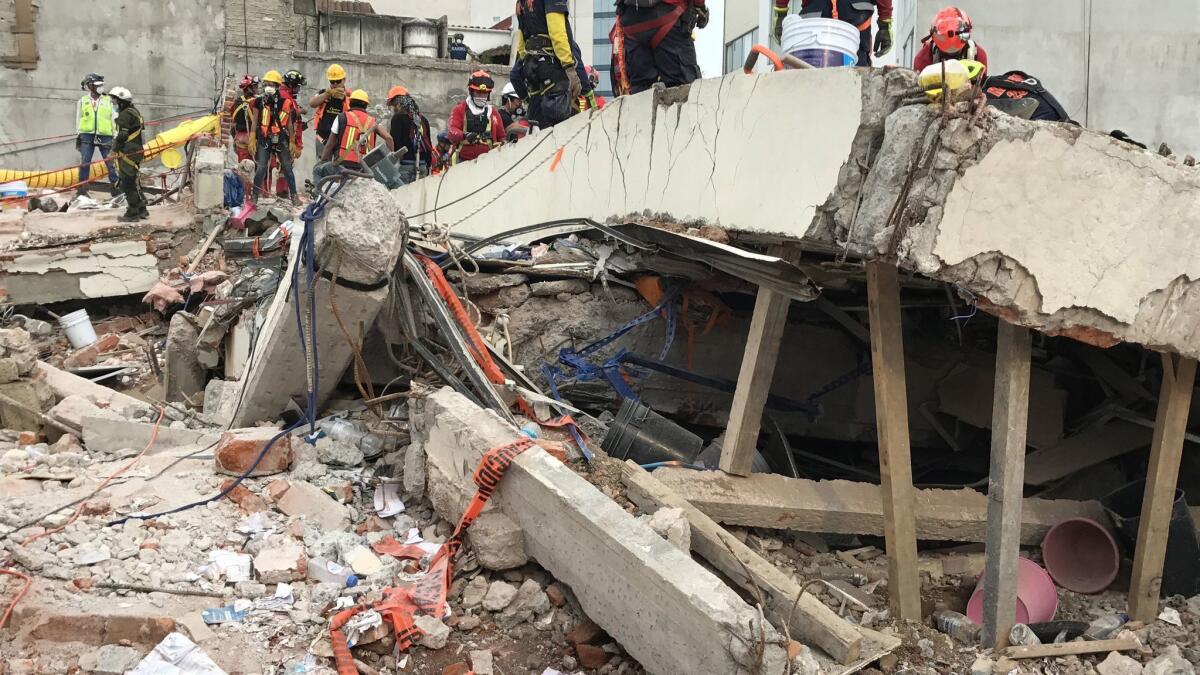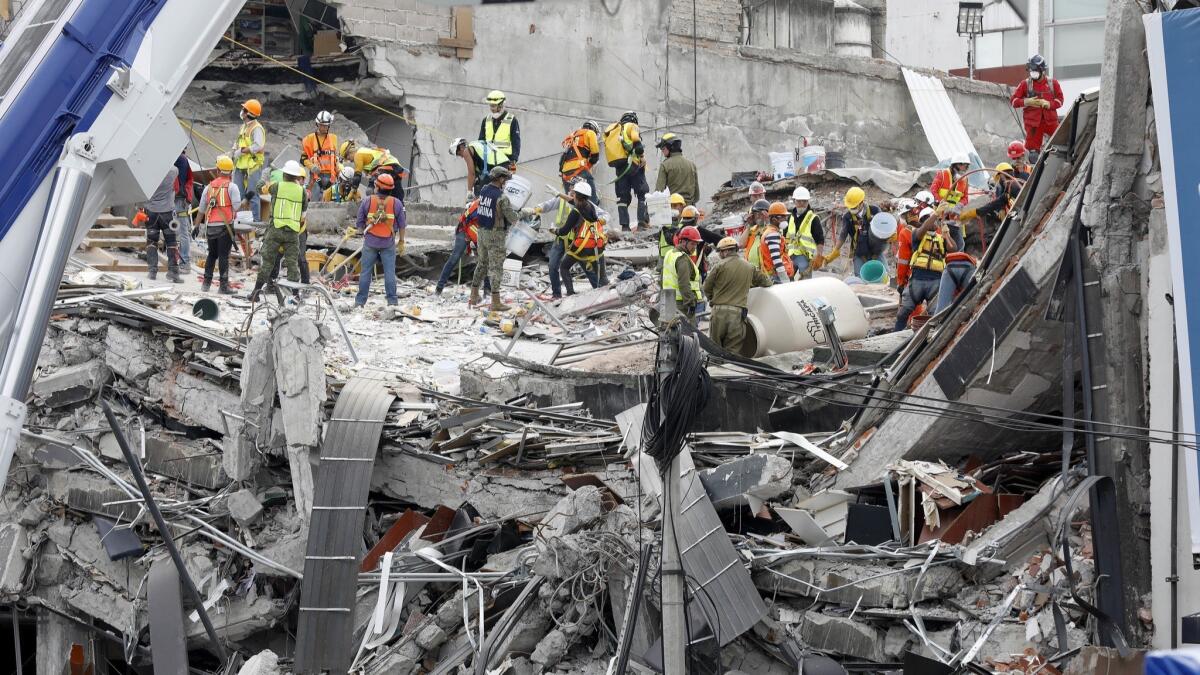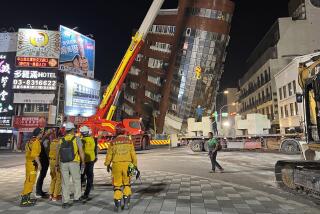Corruption caused the collapse of buildings in 2017 Mexico City earthquake, a new report finds

It was the most powerful earthquake Mexico City had experienced in decades: Magnitude 7.1. Dozens of buildings collapsed in a matter of seconds, leaving occupants little time to flee.
A new report has concluded that it wasn’t the earthquake alone that killed 228 people nearly a year ago in the capital.
An investigation published Tuesday by the nonprofit Mexicans Against Corruption and Impunity found that dozens of buildings that collapsed in the quake had been shoddily constructed and wrongly deemed safe by building inspectors.
Salvador Camarena, a researcher with the group that published the report, said there was “a human explanation” for why some buildings fell while others stood.
“Earthquakes don’t kill people,” Camarena said. “Corruption does.”
The findings were all the more startling because Mexico is considered a world leader in earthquake safety, its strict building codes often held up as models for other seismically active regions.
The regulations, which required contractors to use higher quantities of steel, among other things, were developed after a massive quake in 1985 killed thousands of people and toppled hundreds of buildings.
But in this country where corruption touches every level of society — from local police stations to governors’ mansions — the new regulations have been unevenly enforced.
Over the last year, journalists, academics and a trade group representing architects have independently highlighted gaps in the permitting and inspection system that have allowed unsafe construction to flourish.
Chief among them is the outsourcing of building inspections to private engineers who are hired and paid by developers, an arrangement that gives engineers an incentive to declare buildings safe, even when they aren’t.
In 2016, researchers at the National Autonomous University of Mexico published a study that warned about such conflicts of interest. It found that many of the city’s buildings did not meet the minimum safety requirements and “would have an inadequate performance during an intense earthquake.”

Those predictions came true Sept. 19, when the earth started shaking violently shortly after 1 p.m., bringing down 38 buildings in the capital, including a textile factory, part of a university campus and an elementary school packed with children.
The study released Tuesday found that in the cases of at least 28 buildings, there was evidence of corruption in the safety inspection process, with developers cutting corners to increase profits and on occasion falsifying documents while inspectors looked the other way. More than 5,000 other buildings in the capital suffered serious damage.
The researchers uncovered multiple examples of an engineer signing off on construction that appeared to be faulty.
One case involved a brand new six-story apartment building in the rapidly developing neighborhood of Portales. The investigation found that the developer had ignored recommendations that it build a steel reinforcement cage in the foundation of the building, opting instead to build a cheaper concrete slab. The building also lacked sturdy support columns and had been constructed with rebar not recommended for buildings taller than three stories.
Despite those alleged deficiencies, an engineer signed off on the safety of the building less than a month before the earthquake sent it crashing down, killing two housekeepers — a mother and her daughter — who were working inside the building. Local officials gave their stamp of approval for the building in 2017 as well, even though the final construction did not match the building plans that had been submitted to the government three years before, the report said.
In many cases, neighbors lodged official complaints about the safety or legality of construction but were ignored, according to the report, one of the most detailed investigations into the factors that contributed to the damage in Mexico City.
City officials did not respond to requests for comment Tuesday.
After the quake, then-Mexico City Mayor Miguel Angel Mancera suggested that noncompliance with the new regulations was not a major factor in the damage toll, because most of the buildings that fell were built before 1985, before the new regulations were in place. But the new regulations also applied to any new construction on old buildings — and the tally of destruction included several of those.
One of the owners of the Enrique Rebsamen school, a private academy on the south of the city, had recently built a home for herself on top of the school, according to investigations by local journalists. Engineers said it was the weight of that poorly constructed addition that brought down the building, killing 19 students and seven adults. But just three months before the earthquake, an inspector had deemed the building safe.
The scandal became an issue in this summer’s mayoral campaign because one of the candidates, Claudia Sheinbaum, served as the head of the council district where the school was located.
Sheinbaum, who won in a landslide, told reporters that the school was cited twice for construction without a permit — in 2010 and 2014. Both times, the school paid a fine, applied for a permit after the fact and was allowed to resume construction.
The report also told the story of a large office building in the Condesa neighborhood.

The seven-story building survived the 1985 earthquake, but apparently suffered damage that was never properly repaired. The researchers uncovered an inspection from 20 years ago that said the building was unsafe and shouldn’t be rented. Yet the owners continued renting the space, even removing some support columns to make room for more office space, according to the report.
The building was packed with workers when the earthquake struck. Forty-eight people died, including Noemi Manuel Garcia, a recent college graduate who had just shown up for her first day of work.
Her family camped out for days outside the building as sirens wailed throughout the city and rescuers combed the rubble for survivors.
Her uncle, Juan Pedro Filomeno Manuel, appeared at a news conference where Tuesday’s report was presented and implored authorities to do more to prevent similar tragedies.
“There are acts of God, acts of nature that we can’t do anything about,” he said. “But in this case we know this building was in a very bad state.”
Columnist Hector de Mauleon, who also spoke at the news conference, said he was disappointed that the government doesn’t appear to be adapting in the face of the earthquake. Many damaged buildings are in the process of reconstruction, but the city still relies on privately contracted engineers to sign off on building inspections.
“This is going to keep happening,” he said. “Nothing has changed.”
He criticized officials for prioritizing economic development over safety, noting that much of the city’s recent explosion in building has occurred in areas, such as the Condesa neighborhood, that are widely known to sit on tectonic rifts.
Authorities, he said, “allowed a shameless real estate boom in areas where there were known fault lines.”
Twitter: @katelinthicum
Cecilia Sanchez in The Times’ Mexico City bureau contributed to this report.
More to Read
Start your day right
Sign up for Essential California for news, features and recommendations from the L.A. Times and beyond in your inbox six days a week.
You may occasionally receive promotional content from the Los Angeles Times.







